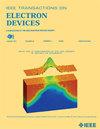A Memristor-Based Infrared Reservoir Computing System for Dynamic Target Perception With Spatial–Temporal Features
IF 2.9
2区 工程技术
Q2 ENGINEERING, ELECTRICAL & ELECTRONIC
引用次数: 0
Abstract
The rapid expansion of the Internet of Things (IoT) necessitates unprecedented resource efficiency in sensor-edge hardware to implement artificial intelligence (AI). A memristor-based infrared reservoir computing (MIRC) system was proposed in this work, incorporating a physical mask, a pyroelectric infrared (PIR) sensor based on LiTaO3 (LT), and a memristor based on LiNiO3 (LN). The PIR sensor with the physical mask can encode spatiotemporal features into electrical signals with high data fidelity. Subsequently, the analog sensor signals can be directly fed to the delay-based memristor reservoir. It is worth mentioning that the memristor shows a large dynamic space with rich reservoir states and a nonlinear short-term memory effect, so that the spatiotemporal features of PIR signals can be mapped more finely to the conductance of the memristor. These advancements in memristor performance enhance the system’s ability to process complex spatiotemporal data, allowing for the perception of targets with varying sizes, velocities, and distances, with results indicating a high distinction for each target. Compared to conventional methods, this approach significantly saves hardware resources, minimizes data transmission requirements, and simplifies backend algorithmic processing, providing a promising framework for advancing IoT technologies with integrated AI capabilities at the sensor edge.基于忆阻器的具有时空特征的动态目标感知红外储层计算系统
物联网(IoT)的快速发展要求传感器边缘硬件的资源效率达到前所未有的水平,以实现人工智能(AI)。本文提出了一种基于忆阻器的红外储层计算(MIRC)系统,该系统包括物理掩膜、基于LiTaO3 (LT)的热热红外(PIR)传感器和基于LiNiO3 (LN)的忆阻器。带物理掩膜的PIR传感器可以将时空特征编码成数据保真度高的电信号。随后,模拟传感器信号可以直接馈送到基于延迟的忆阻器储存器中。值得一提的是,忆阻器具有丰富的储层状态和非线性短期记忆效应的大动态空间,可以更精细地将PIR信号的时空特征映射到忆阻器的电导上。忆阻器性能的这些进步增强了系统处理复杂时空数据的能力,允许感知不同大小、速度和距离的目标,结果表明每个目标都有很高的区别。与传统方法相比,这种方法显著节省了硬件资源,最大限度地降低了数据传输要求,并简化了后端算法处理,为在传感器边缘集成AI功能的物联网技术提供了一个有前途的框架。
本文章由计算机程序翻译,如有差异,请以英文原文为准。
求助全文
约1分钟内获得全文
求助全文
来源期刊

IEEE Transactions on Electron Devices
工程技术-工程:电子与电气
CiteScore
5.80
自引率
16.10%
发文量
937
审稿时长
3.8 months
期刊介绍:
IEEE Transactions on Electron Devices publishes original and significant contributions relating to the theory, modeling, design, performance and reliability of electron and ion integrated circuit devices and interconnects, involving insulators, metals, organic materials, micro-plasmas, semiconductors, quantum-effect structures, vacuum devices, and emerging materials with applications in bioelectronics, biomedical electronics, computation, communications, displays, microelectromechanics, imaging, micro-actuators, nanoelectronics, optoelectronics, photovoltaics, power ICs and micro-sensors. Tutorial and review papers on these subjects are also published and occasional special issues appear to present a collection of papers which treat particular areas in more depth and breadth.
 求助内容:
求助内容: 应助结果提醒方式:
应助结果提醒方式:


